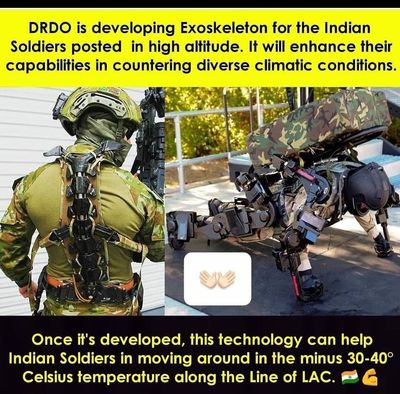Exoskeleton :-
The earliest-known exoskeleton-like device was an apparatus for assisting movement developed in 1890 by Russian engineer Nicholas Yagin. It used energy stored in compressed gas bags to assist in movement, although it was passive and required human power. In 1917, United States inventor Leslie C. Kelley developed what he called a pedomotor, which operated on steam power with artificial ligaments acting in parallel to the wearer's movements. This system was able to supplement human power with external power.
In the 1960s, the first true 'mobile machines' integrated with human movements began to appear. A suit called Hardiman was co-developed by General Electric and the US Armed Forces. The suit was powered by hydraulics and electricity and amplified the wearer's strength by a factor of 25, so that lifting 110 kilograms (240 lb) would feel like lifting 4.5 kilograms (10 lb). A feature called force feedback enabled the wearer to feel the forces and objects being manipulated.

The Hardiman had major limitations, including its 680-kilogram (1,500 lb) weight. It was also designed as a master-slave system: the operator was in a master suit surrounded by the exterior slave suit, which performed work in response to the operator's movements. The response time for the slave suit was slow compared to a suit constructed of a single layer, and bugs caused "violent and uncontrollable motion by the machine" when moving both legs simultaneously.
Hardiman's slow walking speed of 0.76 metres per second (2.5 ft/s or just under 2 mph) further limited practical uses, and the project was not successful.
In 1972, an active exoskeleton for rehabilitation of paraplegics that was pneumatically powered and electronically programmed was tested at Belgrade Orthopedic Clinic.
In 1985, an engineer at Los Alamos National Laboratory (LANL) proposed an exoskeleton called Pitman, a powered suit of armor for infantrymen.[13] The design included brain-scanning sensors in the helmet and was considered too futuristic; it was never built.[14]
In 1986, an exoskeleton called the Lifesuit was designed by Monty Reed, a US Army Ranger who had broken his back in a parachute accident.[15] While recovering in the hospital, he read Robert Heinlein's science fiction novel Starship Troopers, and Heinlein's description of mobile infantry power suits inspired
Classification :-
Exoskeletons are not only designed for specific body parts; the exoskeletons may be designed more generally for only one hand, a leg, or even the complete body. Thus, the separation of the classes demonstrates the most common body parts exoskeletons can be built for. The full-body class refers to the exoskeletons made to assist all the limbs, or most of the body. The upper body refers to the exoskeletons made for the upper limbs, and involving the chest, head, back, and/or shoulders. The lower body category refers to the exoskeletons made for the lower limbs: thighs, lower legs, and/or hips. Moreover, there are classes for specific limbs and specific joints. These classes include exoskeletons designed for the knee, ankle, hand, arm, foot, etc. Additionally, there is a special class for any other exoskeleton that is not included in the previous classes.
Rigid exoskeletons are those whose structural components attached to the user’s body are made with hard materials. Such materials include metals, plastics, fibers, etc. On the other hand, soft exoskeletons, also called exo-suits, are made with materials that allow free movement of the structural components. Exo-suits are often made with, yet not restricted to, textiles.
Indian Army :-
Defence Research and Development Organisation (DRDO)’s Defence Bioengineering and Electro-medical Laboratory (DEBEL) has been collating data for Simulation and Analysis of Musco-skeletal parts for a while, and defence ministry is already incurring expenditure on upgrading wearable gear on each soldier to meet the ever-changing combat environment challenges.
Several private sector companies too are doing research and development for the Exo-suit design for the conditions specific to Indian soldier.
Artificial Intelligence and C4I expert Milind Kulshreshtha states that each of the soldier’s muscle micro-motion is measured for its correlated moment on the joints, so that a similar smooth response from the Exo-suit can be obtained.
For Military applications, an Exo-suit rigged up on a soldier is expected to enhance the soldier’s additional load carrying capacity by 100 kg for a minimum of 8 hours of operational time and 3-5 hours of battery backup, he was quoted as saying by Financial Express.
Exo-suits can also help soldiers who have been disabled in the combat to live a close to normal life.
Once it's developed, this technology can help
Indian Soldiers in moving around in the minus 30-40° Celsius temperature along the Line of LAC.
Last December (2020), in response to a question by Financial Express Online, DRDO had said that, “For enhancing Indian soldiers’ performance in military scenarios, several configurations including lower/upper extremity, and full-body exoskeletons are being developed and several DRDO labs are involved in this.”
In June 2021, responding to Financial Express Online on the current status of Exoskeletons, DRDO in an email response says: “DRDO has been entrusted with a requirement to augment the soldier’s capability during logistics activities performed by the military. Therefore, the biomechanical characteristics of the soldier during various logistics activities such as transportation of goods, ration, ammunition etc., through diverse terrain, for long distances with their complete military gear has been systematically captured and analyzed.”
Thanks for reading my blog...
If you like it the share with your friends...
And if you like to get information about the Smartphone just follow my blog page...






Proudful 🎖️
ReplyDeletePost a Comment
If you want to know anything or you have any kind of doubts. Just let me know and ask it in the comments and I will answer it confirmed.